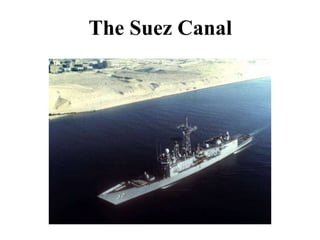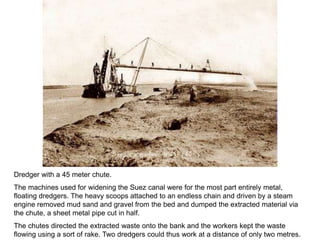Suez Canal.ppt
- 2. Background
- 3. Geology
- 4. N
- 10. Dredger with a long chute. In the areas where the canal was at its widest, the chutes reached sixty meters long. In order to the maintain the equilibrium of the dredger ensemble, semi-cylindrical chutes, sixty centimeters deep, were carried on reinforced posts placed on a barge. The canal banks here are protected from erosion caused by passing boats by riprap.
- 11. Dredger with a 45 meter chute. The machines used for widening the Suez canal were for the most part entirely metal, floating dredgers. The heavy scoops attached to an endless chain and driven by a steam engine removed mud sand and gravel from the bed and dumped the extracted material via the chute, a sheet metal pipe cut in half. The chutes directed the extracted waste onto the bank and the workers kept the waste flowing using a sort of rake. Two dredgers could thus work at a distance of only two metres.
- 12. Dredger with a Dumper. In the lakes or near the sea, excavation was done using dredgers with dumpers. The dredger is shown here raised up awaiting a barge to take the debris away.
- 13. Dredger and Nud Barge. The excavated mud was loaded onto nud barges which transported it either to the deeper waterways or to the sides of the lakes.
- 14. Ship and Dredger. At every step of the way, the boats using the Suez canal passed machines engaged in widening the canal, without, it would seem, any difficulty.
- 15. Excavation on dry land to widen the canal In the areas where the terrain was particularly hard, more traditional methods were used to widen the canal: debris was extracted by hand, using picks, and loaded into crates which were carried to the dump by camels.
- 16. Close Up of dredger and crew. A crew poses for a picture on their dredger.
- 17. Widening of the canal. Work to protect the canal banks. The Egyptian navvies dug out the earth using a sort of local pick, called a fass. The overseers here sitting on the bank look on. A drainage pump, driven by a steam engine set up in a hut, helped prevent the trenches becoming waterlogged.
- 18. Work to widen the canal. Trucks full of debris have just unloaded their loads onto the side whilst a worker holds a graduated leveling rod to indicate the level at which the debris should be.
- 19. Port Said. View of the town port. After an obligatory stop so as to complete the administrative formalities and to pay the rights of passage, ships from the Mediterranean then entered the canal.
- 20. Port Said. Company workshops. Fitting and founding. The workshops were divided according to their tasks: in one hulls and engines were repaired, whilst in another fitting and founding was done; yet others were reserved for smelting, woodwork and carpentry.
- 21. Port Said. The Arsenal dock. Company workshop. Built during the digging of the canal, the great workshops of Port Said were heavily involved in the construction work. In them the excavation machinery was assembled, and the various types of vessels were maintained and repaired from the damage which occurred during their passage through the canal.
- 22. Ismailia. De LessepsĄŊs house. A one-time diplomat, Ferdinand de Lesseps created the Compagnie universelle du canal maritime de Suez (The Universal Company of the Maritime Suez Canal), and made himself president. In Ismailia, on the Mohammed-Ali quay he had built a house facing the freshwater canal, and it was here that he lived when he stayed on the isthmus. To the right can be seen the roof of the permanent residence of the engineer Voisin, the man who directed the construction work for the company until the opening ceremony.
- 23. Ismailia. Lodgings for Company mechanics. Trees were planted along the wide streets of Ismailia so as to provide some shade from the fierce sun. Ismailia was the administrative capital of the Suez Company. Here the clothes and buildings are in imitation of the those of Paris.
- 24. Suez Port Ibrahim dry dock Here workers could repair hulls and perform other maintenance duties on ships.
- 25. Port Thewfik Hardly in existence before the construction of the canal, this city at the canalĄŊs exit into the Gulf of Suez and the Red Sea boomed after the canalĄŊs completion.
- 26. Isolation barges for pilots in quarantine. The Universal Suez Canal Company was very concerned about the health of its employees. When epidemics broke out, isolations barges had to be built to provide places of quarantine in which to care for the sick workers.
- 27. The Official Stand at the Inauguration of the Canal, 29 November, 1869
- 28. After it was opened to navigation in 1869, the 163 km (101 mi) Suez Canal measured 8m (26 feet) deep, 22m (72 feet) wide at the bottom, and 70m ( 230 feet) wide at the surface. It is the longest canal with no locks.
- 29. Military Conflict ? 1936 - Egypt signs treaty allowing Britain to keep military forces in canal zone. ? 1948 - Egypt begins preventing all Israeli ships from using canal. ? 1951, Sep 1 - UN Security Council orders Egypt to open canal to Israeli ships. ? Meanwhile, Egypt is talking trash against Israel. ? 1955, Aug 31 - Gamal Abdel Nasser, Egyptian President, announces fedayeen. ? 1956, July 26 - Egypt seizes canal and declares it a national asset. ? 1956, October 29 - Israel launches the Sinai Campaign. ? 1956, October 30 - The Israel UN representative explains the situation to the UN. Background
- 30. The Sinai Campaign (1956) ? 100,000 soldiers mobilized in 72 hrs. ? Israeli Airforce operational in 43 hours. ? Israel advances unopposed until halted by demands of England and France backers. ? Egypt given a chance to withdraw, claiming to be the Ą°victimsĄą. ? Oct 30th - US sponsors a UN resolution demanding an immediate Israeli withdrawal, but France and Britain veto it and begin bombing Egyptian airfields near Suez. ? Israel continues the fight capturing almost the entire Sinai by November 5th. The British and the French land paratroops and amphibious troops near Port Said. ? British about-face based on Soviet and American pressure. French want to keep going. ? Ike, pissed off that this all happened without him knowing, forces Israel to withdraw. Egypt concedes nothing setting up the conditions for the 1967 Arab-Israel war. ? Fedayeen re-organized a few years later as the PLO.
- 31. Vessel Type Containers Tanker Bulk Carrier Ro-Ro Passengers Car Carrier General Cargo Combined Carrier Lash War Vessels Others Total January 367 201 228 33 2 82 164 3 2 19 49 1,150 February 348 182 214 17 3 65 143 4 3 18 56 1,053 March 373 171 219 19 12 71 147 2 1 26 47 1,088 April 390 203 244 22 13 68 163 4 4 12 57 1,180 May 378 233 241 24 7 65 170 6 1 28 57 1,210 June 373 242 223 26 4 66 162 10 3 17 43 1,169 July 391 252 253 20 5 65 174 12 3 14 52 1,241 August 403 213 270 21 1 70 172 10 2 18 59 1,239 September 402 226 240 25 2 57 179 6 2 16 42 1,197 October 395 214 274 18 9 61 170 4 3 7 66 1,221 November 386 213 249 15 14 62 167 3 3 9 66 1,187 December 403 213 265 30 6 58 157 6 1 12 55 1,206 Total 4,609 2,563 2,920 270 78 790 1,968 70 28 196 649 14,141 Suez Canal Traffic - January - December, 2000 ITEM UNIT 1869 1956 1962 1980 1994 1996 1999 PRESENT WIDTH AT 11M DEPTH M 44 60 90 160 180/210 180/210 200/210 same MAX DRAFT OFSHIPS FEET 22 35 38 53 56 58 58 60 OVERALL LENGTH KM 164 175 175 190.25 190.25 190.25 190.25 190.25 DOUBLED PARTS KM - 29 29 78 78 78 78 78 WATER DEPTH M 10 14 15.5 19.5 20.5 21 21 same CROSS SECTIONAL AREA M2 304 1100 1800 3600 3800/4300 3900/4500 4100/4500 same MAX. TONNAGE (DWT) TON 5000 30000 80000 150000 180000 185000 195000 same Historical Stats of the Suez Canal Canal Stats and Use Today






























